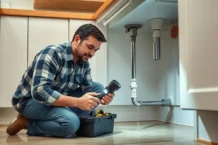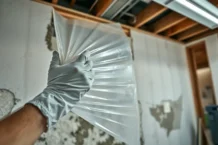Did you know that washing machine flood-related failures are among the top 10 leading sources of residential water loss? These failures cost an average of $5,308 per incident after the homeowner’s insurance deductible was paid. Most of these claims came from water supply hose failures, but other causes included overflow (too many suds), drain failure, machine leak, or a broken internal component. So what do you do if your washing machine causes a washing machine flood in your San Diego home?
Washing Machine Flood – San Diego CA
The mess and the cost of a washing machine flood can be very expensive. Per load, conventional washers consume at least 30 gallons of water. (Energy Star-rated ones use around 10 to 20 gallons).
Make safety a priority and avoid flooding the washing machine.
Washing machines are a convenient and essential household appliance, but they can also be a source of household disasters if not properly maintained. A washing machine flood can cause extensive damage to your home, leading to costly repairs and insurance claims. This comprehensive guide will walk you through the steps to safeguard your home from washing machine floods.
First and foremost, regular maintenance is key. Properly caring for your washing machine includes checking the hoses for any signs of wear or leaks, cleaning the lint trap after each use, and scheduling professional inspections every few years.
Additionally, installing a flood prevention device can provide an extra layer of protection. These devices can detect leaks, shut off the water supply, and even send alerts to your phone, giving you peace of mind when you’re away from home.
These preventative measures can minimize the risk of a washing machine flood and protect your home from potential damage. So, let’s dive in and learn how to safeguard your home from this potential hazard.
Remember, prevention is always better than a flooded home.
The importance of preventing washing machine floods
Washing machine floods are a serious issue that can cause significant damage to your home and belongings. These types of floods can lead to costly repairs, water damage, and even the growth of mold and mildew. Preventing a washing machine flood should be a top priority for any homeowner or renter.
The impact of a washing machine flood can be devastating. Depending on the severity of the flood, you may need to replace flooring, drywall, furniture, and even electrical systems. The cleanup process can be time-consuming and expensive, and the resulting water damage can lead to long-term issues like structural problems or health concerns. Additionally, a washing machine flood can disrupt your daily routine and cause significant inconvenience.
Preventing a washing machine flood is crucial to protecting your home and your finances. You can significantly reduce the risk of a flood and the associated consequences by taking proactive steps to maintain your washing machine and installing protective devices. In this guide, we’ll explore the common causes of washing machine floods, the signs to look out for, and the steps you can take to safeguard your home and your peace of mind.
Common causes of washing machine floods
Washing machine floods can be a major headache, causing water damage and costly repairs. Here are some common causes:
- Faulty Hoses: Worn-out or improperly connected hoses can burst or leak, leading to flooding.
- Clogged or Blocked Drains: Water can back up and overflow if the washing machine’s drain is clogged.
- Overloading: Overfilling the washing machine with clothes can cause it to become unbalanced, leading to excess water spilling out.
- Faulty Water Inlet Valve: If the water inlet valve malfunctions, water can continuously flow into the machine, resulting in overflow.
- Improper Detergent Use: Too much detergent or the wrong type can cause excessive suds, which can overflow from the machine.
- Damaged Door Seal: A damaged or worn door seal can allow water to escape during the wash cycle in front-loading washers.
- Internal Mechanical Failures: Issues with the washing machine’s internal components, such as a broken water pump or pressure switch, can lead to flooding.
Regular maintenance and inspection of your washing machine can help prevent these issues and avoid potential floods.
Signs of a potential washing machine flood
Recognizing the signs of a potential washing machine flood is crucial in preventing a disaster. One of the most obvious signs is water leaking from the washing machine. This could be a slow drip or a more significant leak, but it indicates an issue that needs to be addressed.
Another sign to watch out for is unusual noises from the washing machine, such as grinding, banging, or squeaking. These sounds can signify a problem with the internal components that could lead to a flood.
If you notice that the washing machine is taking longer than usual to complete a cycle or that the water isn’t draining properly, these could also be signs of an impending flood. Additionally, if the floor around the washing machine is damp or you notice water stains on the walls or ceiling, these are clear indications that a flood may be imminent.
Tips for preventing washing machine floods
Preventing a washing machine flood starts with regular maintenance and vigilance. One of the most important steps is to regularly inspect the hoses for any signs of wear or damage. Look for cracks, bulges, or loose connections, and replace the hoses if necessary.
Cleaning the lint trap after each use is also a good idea. A clogged lint trap can lead to drainage issues and a flood. You should also periodically check the drain line for blockages or debris buildup.
Another important step is to avoid overloading the washing machine. Follow the manufacturer’s recommended maximum load size and do not exceed the machine’s capacity. This will help prevent strain on the internal components and reduce the flood risk.
Regular maintenance to reduce the risk of flooding
Regular maintenance is crucial in preventing washing machine floods. One of the most important tasks is to inspect and replace the hoses if necessary. Washing machine hoses are typically made of rubber or plastic, and over time, they can become brittle, cracked, or worn, leading to leaks and eventual flooding.
You should replace your washing machine hoses every 3-5 years or sooner if you notice any wear or damage. When replacing the hoses, be sure to use high-quality, reinforced hoses designed to withstand the pressure and temperature of the washing machine.
Another important maintenance task is to clean the lint trap after each use. A clogged lint trap can restrict water flow, leading to drainage issues and potentially a flood. Be sure to remove any lint or debris from the trap, and consider using a small brush or vacuum attachment to ensure a thorough cleaning.
Installing a washing machine flood prevention system
In addition to regular maintenance, a washing machine flood prevention system can provide extra protection for your home. These devices are designed to detect leaks and automatically shut off the water supply to the washing machine, preventing a flood from occurring.
Several types of flood prevention systems are available, including water sensors that detect moisture and shut off the water and automatic shut-off valves that can be connected to your home’s plumbing. Some systems even come with mobile app integration, allowing you to monitor and control the device remotely.
When choosing a flood prevention system, consider factors such as ease of installation, compatibility with your washing machine and plumbing, and the level of automation and monitoring capabilities. Investing in a quality flood prevention system can provide peace of mind and help protect your home from the devastating effects of a washing machine flood.
Insurance coverage for washing machine floods
While taking preventative measures is crucial in avoiding washing machine floods, it’s also important to understand your insurance coverage if a flood does occur. Many homeowners’ or renters’ insurance policies cover water damage caused by a washing machine flood, but the extent of the coverage can vary.
It’s important to review your policy and understand the limits and exclusions. Some policies may have a deductible or cap on coverage, while others may not cover certain types of water damage or require the use of specific contractors.
If you’re unsure about your coverage, contacting your insurance provider and discussing your specific situation is a good idea. They can help you understand your policy and ensure that you have the appropriate coverage to protect your home and belongings in a washing machine flood.
Steps to take if a washing machine flood occurs
One may still occur despite your efforts to prevent a washing machine flood. If this happens, acting quickly to minimize the damage and mitigate the consequences is important.
The first step is to turn off the water supply to the washing machine. This will stop the flow of water and prevent the flood from worsening. Next, unplug the washing machine and move any nearby electrical devices to a safe, dry location.
Once the water flow has stopped, you must begin the cleanup process. Use towels, mops, and a wet/dry vacuum to remove as much standing water as possible. Be sure to also check for any water damage to the surrounding areas, such as the floor, walls, or cabinetry, and address those issues.
Professional help for dealing with washing machine floods
If the flood is extensive or you suspect that there may be significant water damage, it’s best to call in a professional. Water damage restoration experts have the knowledge, equipment, and experience to properly assess the situation and take the necessary steps to mitigate the damage and prevent further issues.
These professionals can use specialized drying equipment, such as dehumidifiers and air movers, to remove any remaining moisture and prevent mold or mildew growth. They can also inspect your home’s structural integrity and identify any hidden water damage that may not be immediately visible.
In addition to water damage restoration, you may also need to call in a plumber to inspect and repair any issues with your washing machine or the surrounding plumbing. A professional plumber can identify the root cause of the flood and ensure that the problem is properly addressed to prevent future occurrences.
Conclusion: Ensuring peace of mind with proper prevention measures
Preventing washing machine floods is a crucial task for any homeowner or renter. By understanding the common causes, recognizing the signs of a potential flood, and taking proactive steps to maintain your washing machine and install protective devices, you can significantly reduce the risk of a devastating flood.
Regular maintenance, such as inspecting the hoses and cleaning the lint trap, is essential in keeping your washing machine in top condition and reducing the likelihood of flooding. Additionally, investing in a quality flood prevention system can provide extra protection and peace of mind, especially when you’re away from home.
While no preventative measure can guarantee that a washing machine flood will never occur, taking the steps outlined in this guide can go a long way in safeguarding your home and minimizing the potential for damage. By being proactive and vigilant, you can protect your home, belongings, and finances from a washing machine flood’s costly and inconvenient consequences.










Follow Us!